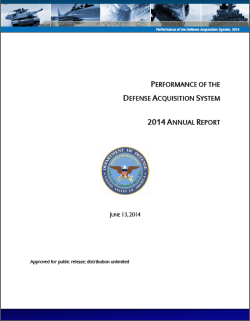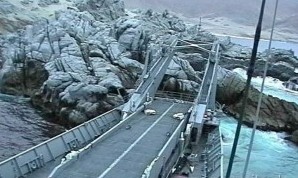What’s up with that kooky title? Well that’s how all your email coming from outside the “dot mil” domain appears to those inside…As if they are somehow more secure? I guess this is an attempt to highlight emails coming from us pogues outside the secure boundaries of DoD email and to alert those on the inside that there is danger in communicating outside the domain….![]() Personally, I would like all their outgoing email to be marked [DoD Source] so I can choose not to read some of the mountains of stuff that comes out from them…Like the DoD media reports that give us a detailed “Readout of SecDef meeting with the Dali Lama” and the like (See the News section of this web site). I don’t think I have ever finished one of those “Readouts”, because frankly, there’s nothing of substance in them. Does anyone outside the Pentagon really care?(and I’m pretty sure only a very select few inside do) That’s a candidate for [DoD Source] marking so I can avoid it. And yet, some GS-15 is probably making a lot of money producing them. There’s also the de rigueur morning DoD press reports of the wildly successful strikes against ISIL targets conducted by our forces overnight. Yet another candidate to be marked [DoD Source]. I guess I have just become overwhelmed by all the happy talk to the point that I just don’t have confidence that everything I read is really “true.”
Personally, I would like all their outgoing email to be marked [DoD Source] so I can choose not to read some of the mountains of stuff that comes out from them…Like the DoD media reports that give us a detailed “Readout of SecDef meeting with the Dali Lama” and the like (See the News section of this web site). I don’t think I have ever finished one of those “Readouts”, because frankly, there’s nothing of substance in them. Does anyone outside the Pentagon really care?(and I’m pretty sure only a very select few inside do) That’s a candidate for [DoD Source] marking so I can avoid it. And yet, some GS-15 is probably making a lot of money producing them. There’s also the de rigueur morning DoD press reports of the wildly successful strikes against ISIL targets conducted by our forces overnight. Yet another candidate to be marked [DoD Source]. I guess I have just become overwhelmed by all the happy talk to the point that I just don’t have confidence that everything I read is really “true.”
Now hold on there you DoD buckaroos!!!!! I’m not saying that what you put out is not “True”, but I think we can all agree that words can be put together is a way that while they are true, they may not be “truthful.” I put on an occasional seminar on Ethical Decision Making and in that class I discuss some points concerning “truth.”  Perhaps the most famous seeker of a definition of truth was Pontius Pilate when he asked, “What is truth?” He didn’t get an answer to his question then and the answer to his question has been debated for centuries. In my previous article , Sigh-ber, I touched upon the wisdom of always being completely truthful so I won’t jump into that morass again. But is always just telling happy truth, and ignoring some of the bad news, being completely truthful? I think not. I recall during one session on the Hill when I was asked if we had fully funded the ship maintenance requirement I replied, “Yes Sir. We have fully funded the ship maintenance line to 75% of the requirement!” True enough! Anyway, I digress.
Perhaps the most famous seeker of a definition of truth was Pontius Pilate when he asked, “What is truth?” He didn’t get an answer to his question then and the answer to his question has been debated for centuries. In my previous article , Sigh-ber, I touched upon the wisdom of always being completely truthful so I won’t jump into that morass again. But is always just telling happy truth, and ignoring some of the bad news, being completely truthful? I think not. I recall during one session on the Hill when I was asked if we had fully funded the ship maintenance requirement I replied, “Yes Sir. We have fully funded the ship maintenance line to 75% of the requirement!” True enough! Anyway, I digress.
I am somehow offended that DoD chooses to mark my email as [Non-DoD Source]. I suppose I should be grateful that they deign to open my “insecure” emails. Given the thousands of emails folks receive in the Pentagon, my guess is that they will all become desensitized to that phrase and will ignore it. But……if someone ever clicks on a [Non-DoD Source] email and causes some sort of bot or bug or worm or virus to be introduced into that bastion of security, the “dot mil” domain, the Cyber-police will descend upon them for ignoring the [Non DoD Source] warning. I am sure the cyber-Dons within DoD are correct when they believe that this sort of thing can’t happen from within the “dot mil” domain….But somehow I still see echos of Bradley Mannings, Ed Snowdens and a lot of others who had inside access, that could care less about [Non DoD Source], because they were a [DoD Source]!
PS. My N8 former self can help but wonder how much it cost to mark all non DoD email as [Non DoD Source].
 Please help our wounded Sailors and Coast Guardsmen by attending a performance of “A Christmas Carol”, presented by the Little Theater of Alexandria on the evening of December 16th by clicking here.
Please help our wounded Sailors and Coast Guardsmen by attending a performance of “A Christmas Carol”, presented by the Little Theater of Alexandria on the evening of December 16th by clicking here.






 Second was the publishing of a report by the Senate Permanent Subcommittee on Investigations, Chaired by Senator Levin, with Senator McCain as the Ranking Member. The report, entitled “
Second was the publishing of a report by the Senate Permanent Subcommittee on Investigations, Chaired by Senator Levin, with Senator McCain as the Ranking Member. The report, entitled “ I was prompted to look at it when I saw
I was prompted to look at it when I saw 

